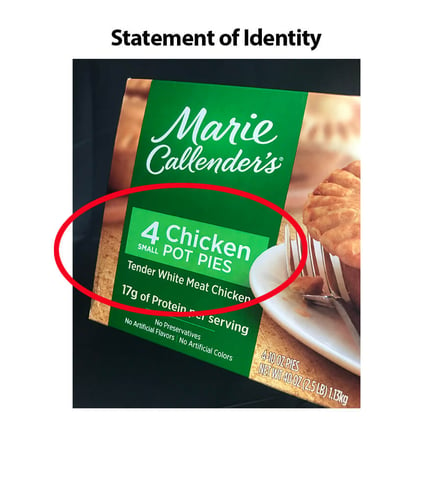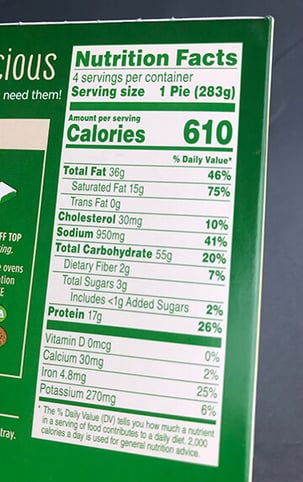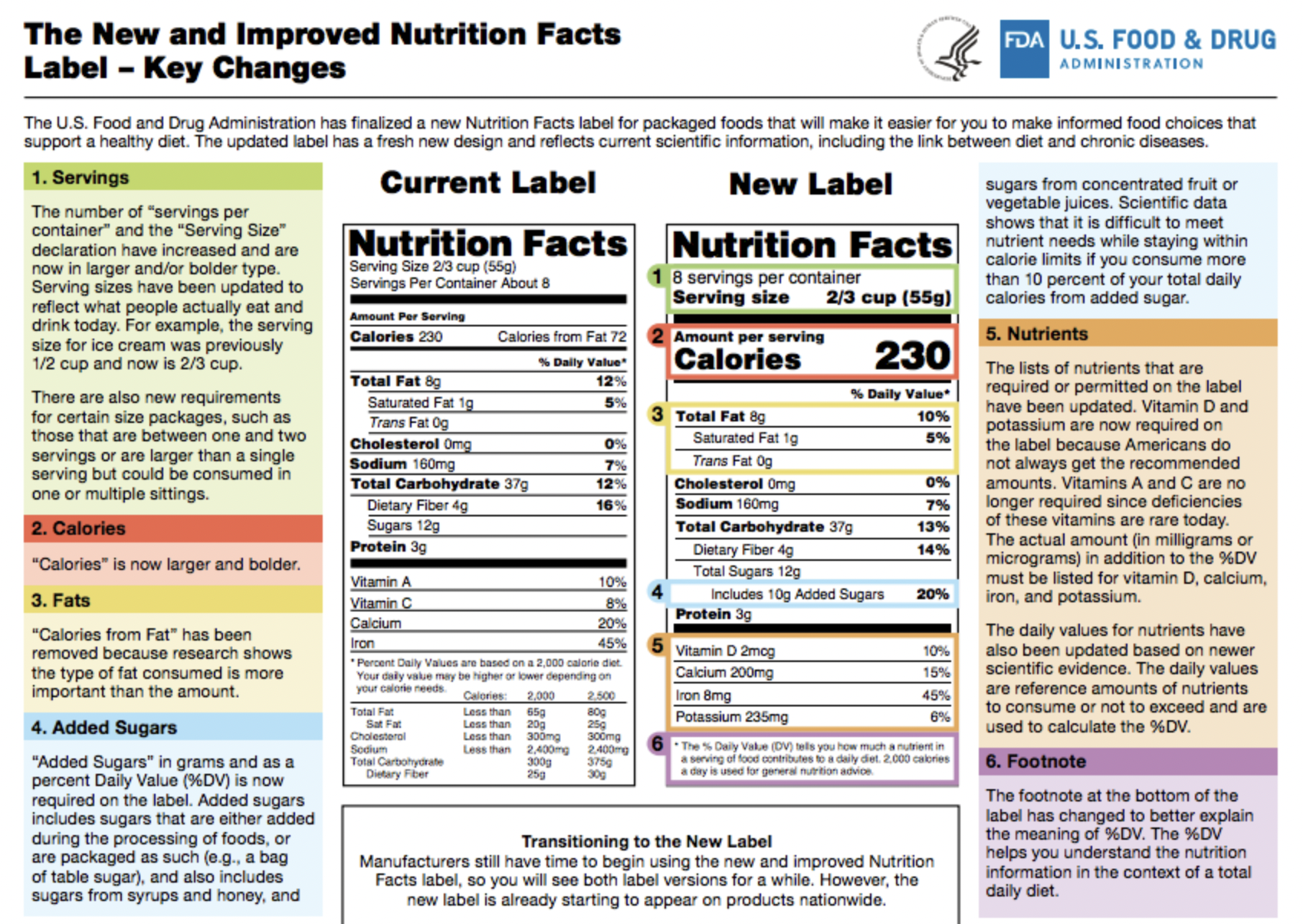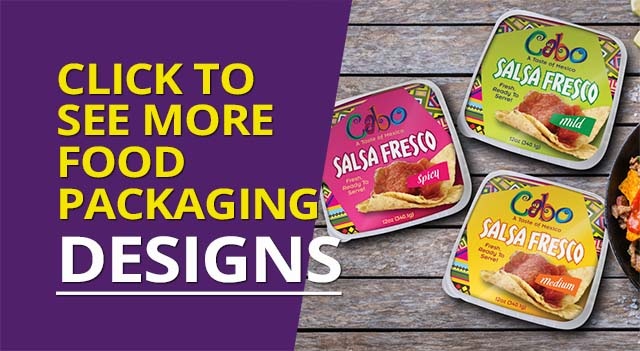
Product packaging not only serves as a means of attracting customers but also plays a critical role in protecting the product from damage, contamination, and spoilage.
In addition to providing a visual branding presence to consumers, packaging materials must be durable, resistant to moisture, and tamper-evident to ensure the safety and integrity of the product.
The packaging materials you use must also withstand varying temperatures, long storage periods, shipping, and other environmental factors.
This is particularly vital in the food and beverage industry but can also apply to other niches such as cosmetics and medical supplies.
In addition to product promotion, branding, and preservation, FDA labeling requirements also set forth specific guidelines for food packaging to provide consumers with detailed nutritional information about the food which must be taken into account in your packaging design.
Below, we take a closer look at what information must be listed on food packaging labels, and the specific formats to adhere to with your product packaging moving forward.
FDA Labeling Requirements Background
The Food and Drug Administration (FDA) is a federal agency responsible for ensuring that all food products sold in the United States are safe, wholesome, and appropriately labeled.
This applies not only to domestically produced food but also to imported products from foreign countries.

The FDA enforces several federal laws, including the Federal Food, Drug, and Cosmetic Act (FD&C Act) and the Fair Packaging and Labeling Act, which set the regulatory standards for food products under the agency's jurisdiction.
The FD&C Act mandates that food products be free of harmful contaminants and additives and labeled with accurate and truthful information about their ingredients, nutritional value, and potential allergens.
Also, the Fair Packaging and Labeling Act requires that all consumer products, including food, be accurately labeled with essential information such as the product name, net quantity, and manufacturer's information.
These regulations are crucial to safeguarding public health and ensuring consumers can access accurate information about their food.
Note that FDA labeling requirements are subject to frequent changes. It is the food industry's responsibility to stay up-to-date with the latest legal requirements for food labeling to avoid any potential violations. The Federal Register (FR) is the primary source for publishing new regulations announced before their effective date. Title 21 of the Code of Federal Regulations (CFR) is a compilation of all laws governing food labeling which is updated annually to reflect any new or modified requirements.
Labeling Areas
FDA labeling requirements reserve specific sections on food packaging to provide consumers with pertinent nutritional information in a consistent format and typography that is easily located as shoppers handle the packaging.
PDP (Principal Display Panel)
The primary display panel (PDP) is part of the product packaging that is most visible to the buyer at the time of purchase.
Accurately determining the PDP area is crucial for complying with FDA regulations that require essential information, such as product name, net weight, and ingredients, to be displayed prominently on the packaging.
In the case of rectangular containers, such as microwavable meal boxes, the PDP area is determined by multiplying the height by the width of the panel.
For cylindrical containers, such as bottles or cans, the PDP area is typically calculated as 40 percent of the product of the height and circumference of the container.

Information Panel
The information panel refers to the board located directly to the right of the PDP or the designated space for cylindrical packaging. The information panel provides consumers with critical information about the product and is essential to food packaging compliance.
This section must contain important information such as the ingredients, nutrition facts, allergen information, and other mandatory labeling information as required by FDA regulations.
Statement of Identity
The Statement of Identity provides consumers with essential information about the product. It includes the legal name of the food, such as "Jif," the common name of the food, such as "peanut butter," or a descriptive name of the food, such as "chunky or smooth peanut butter."
Proper placement and font size for the Statement of Identity are critical factors in ensuring that consumers can quickly and easily identify the product they want to purchase.
To comply with FDA labeling requirements, the Statement of Identity should be prominently displayed on the food packaging's primary display panel (PDP) as one of the main elements.
The font used to display the Statement of Identity should be at least half the size of the largest font used on the package.

Net Quantity
Net quantity refers to the amount of food contained within a package. It is presented as either weight, fluid measure, or the number of individual items.
Providing accurate and precise net quantity information ensures that consumers better understand the amount of food they are purchasing.
This is an essential aspect of food labeling and is required by the FDA to be displayed prominently on the packaging's information panel.
Nutritional Facts
 The Nutrition Facts Label plays a crucial role in providing consumers with essential information about the nutritional content of the food they consume.
The Nutrition Facts Label plays a crucial role in providing consumers with essential information about the nutritional content of the food they consume.
FDA labeling requirements dictate the format of the label based on the size and contents of the package, ensuring that the label's information is clear, accurate, and easy to understand.
The Nutrition Facts panel, along with the ingredient list and allergen warning, is usually displayed on the right-hand panel of the package, within plain sight of the consumer.
If the package doesn't have a right-hand panel, the panel may be placed anywhere else on the package that is easily visible to the consumer.
This section of the package must show the following:
● Serving Size
● Household measuring units
● Servings per container
● Mandatory nutrients, such as total calories, total fats, cholesterol, sodium, dietary fiber, sugar, etc.
The nutritional facts should generally be placed near the Ingredient Statement on the PDP.

Ingredient Statement
The ingredient statement must be displayed on the same panel as the manufacturer's information per FDA labeling requirements.
The list of ingredients is usually located beneath the nutrition facts panel. It is required to include all ingredients in the product.
The FDA mandates ingredients must be listed according to their weight in the product, with the most substantial ingredient first.
The packaging should prominently display the ingredient list in a font no smaller than 1/16 inch in height to ensure easy readability for the consumer. If a food item contains an ingredient that includes sub-ingredients, the sub-ingredients must be listed in parentheses after the primary ingredient to provide complete transparency and clarity to the consumer.
Allergens Declaration
To ensure the safety of consumers with food allergies, food packaging must include allergen warnings if any of the product's top eight allergens are present.
These allergens, which account for 90% of all food allergies, include milk, eggs, fish, crustacean shellfish (such as crab, lobster, and shrimp), tree nuts, wheat, soybeans, and peanuts.
The packaging must include a "contains" statement with the allergen listed (for example, "Contains soy") in the same font size and type as the ingredient list.
Name of Manufacturer, Distributor, or Packer
The name of the maker, packer, or distributor, along with their full street address, must be displayed on the package.
If the packer or distributor's name is shown instead of the manufacturer's name, a qualifying phrase that clarifies the relationship between the firm and the product, such as "manufactured for" or "distributed by," must also be included.
Nutrient Content Claims (NCC)
Nutrient content claims are optional statements on food product packaging that highlight a particular nutritional aspect of the food, such as "Low Fat," "High Fiber," or "Sugar-Free."
While not mandatory, incorporating them into your product label can potentially boost sales. The FDA provides guidelines for valid claims and how they should be presented on the packaging.
These content claims may be placed on or near the PDP, Information Panel, or anywhere else on the package, but the font size cannot be larger than twice that used for the Statement of Identity.
Note that if a Nutrient Content Claim is used, a corresponding Nutrition Facts Panel must be included to show the value of the nutrient claimed.
Expiration, Sell-By, Best Before Dates
Note that some states have specific requirements for food dating, so it's prudent to research the regulations that apply to your area and product.
This expiration information should not obscure any mandatory labeling. It must include the month, day, and year alongside a descriptive term such as "best before" or "sell by."
Latest FDA Labeling Requirements
It’s crucial that you stay up-to-date with the very latest FDA labeling requirements.
As these are updated regularly, it is best to visit the FDA website to ensure you have the most current information on FDA labeling requirements.
Choose Catalpha For Your Food Packaging Needs
Proper food packaging and labeling are crucial to ensuring the safety and satisfaction of consumers. As a leading designer and supplier of retail and online product packaging and displays, here at
Catalpha, we understand the importance of creating food packaging that captures customer attention and drives sales in retail food and e-commerce environments.
Measuring the success of our packaging and floor displays is an integral part of our approach. At Catalpha, we work closely with each of our clients to establish clear objectives and key performance indicators (KPIs) for each display and package campaign.
This approach helps us continuously improve our food packaging and displays, and provide valuable insights to our clients on the performance of their packaging and branding objectives.
Our team of experienced engineers and packaging designers will work with your organization to select suitable materials to promote and package your food products while ensuring compliance with FDA labeling requirements. To find out more about how we can help you with your food packaging requirements, get in touch with our team at Catalpha today.


